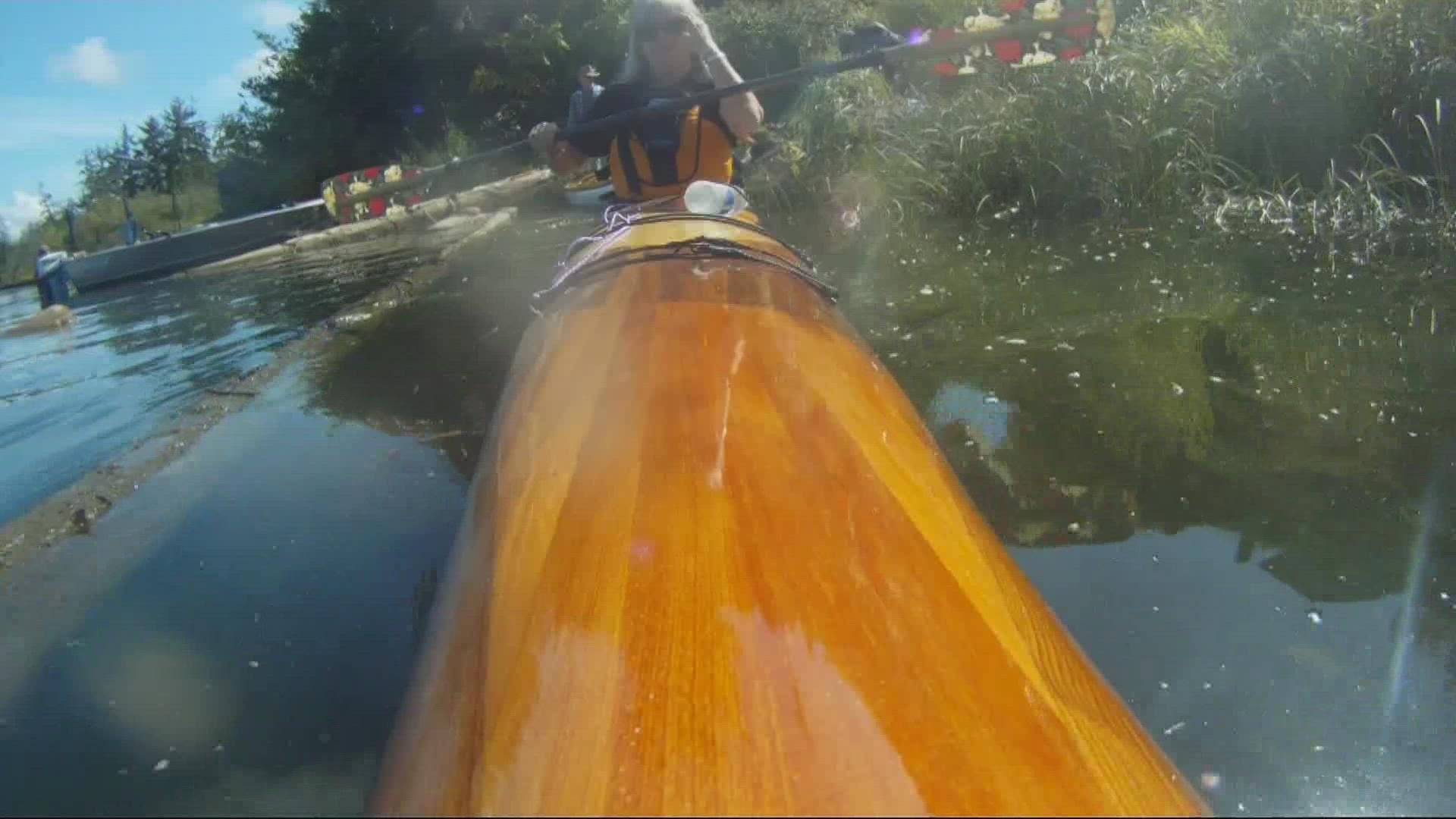ASTORIA, Ore. — On a clear day, the view atop Bradley State Scenic Wayside to the Columbia River is astounding. Picnic tables invite a longer stay in this prime day-use site just off State Highway 30 near Astoria, but it's the river view that begs closer inspection.
So give in and try something new with paddlers who gather to explore Columbia River backwater sloughs and islands.
Steve Gibons is the lead guide of our small paddle team and said that the Lower Columbia River's nooks and crannies provide paddlers a wealth of waterways.
"At this time of year, you cannot ask for better weather – cooler and milder," Gibons said. "So we’re going to paddle upstream (from the Knappa Dock) and then cut into a special site in a Sitka Spruce forest with really big and really old trees. There are two easy-to-reach sloughs that will put us right in the thick of things."
Blind Slough is certainly the "thick of things," over 900 acres of soggy swampland with no land access.
RELATED: Grant's Getaways: Flying Fish
Blind Slough is the last sizable, intact Sitka spruce and tidal-influenced swamp forest of the Columbia River, a habitat type that once stretched from Tillamook Bay north to southeast Alaska. It is home to salmon, beaver, river otter, bald eagles and several other wildlife species.
Fortunately, it was protected by The Nature Conservancy since 1992, who then transferred ownership to the North Coast Land Conservancy in 2019.
The swamp is a braid of channels, separated by acre-sized (or larger) islands. These are soggy places, reminiscent of some distant southern bayou, but of dense willow, alder, and immense Sitka spruce. Some trees rise 200 feet or more and are 400 or more years old.
The native vegetation is a jungle so thick you cannot walk into the islands, but when paddling through the backwater sloughs inside a stable kayak, with time and tides in your favor, the travel is easy and pleasant.
In fact, in this part of the Columbia River, dotted by scores of islands that are separated by dozens of sloughs, a boat is the only way to get around.
Gibons insisted that if you come to visit, remember that safety starts with a life jacket: "It is a state law that you must have one in the boat, but it’s our rule and a smart boating rule that says you wear it at all times."
Boating is only way to take in the huge swamp forest that dates to the 1600’s. Gibons called the trees "absolute giants."
"It was the predominant tree of the coastal northwest 200 years ago," Gibons said. "The Sitka stands ran all the way up the western coastline to Alaska. Some of the trees reach four feet in diameter, so to have a preserve like this is very special."
Historically, these areas flooded each spring from Columbia River runoff, so over time the silt built up and the islands grew larger. The big old Sitka trees could take root and adapt to the moist soil. Along the southern edge of the Columbia River, water is washing through the preserve all of the time and that makes it a rich place for salmon, waterfowl and the larger predators like osprey, bald eagles and even bears.
When you visit, I hope you feel as I did, that despite being a short 80 miles from Portland, you are in the middle of nowhere. There are very few places in western Oregon that allow that sense of escape and that is not lost on the other paddlers in our small paddling party.
"I've never seen anything like this anywhere else," said longtime paddler Bonnie Gibons. "It’s the size of the trees, the quiet and just being able to experience the outdoors here is wonderful."
"I find it rejuvenating," said Tracey Cole. "I just feel younger getting out on the water and this is not very far from home."
Of the many ways I’ve journeyed throughout Oregon, paddling is the most intimate way to touch nature. It's easy and quiet, and you never know what you’re going to see: perhaps an eagle roosting in a towering spruce or a beaver or muskrat cruising by, maybe even a pond turtle basking on a log in the warm, waning afternoon sun. Paddling offers time well spent in the Oregon outdoors.
Note: Blind Slough is accessible only by canoe or small boat. The tides here can be strong and so can the winds. Please respect private-property signs and avoid the log rafts. September and October are excellent times to visit Blind Slough.
Directions: From Portland, travel west approximately 80 miles to Knappa Junction. Turn north at the Logger Café. In less than a quarter-mile, turn right onto Brownsmead Road and travel approximately 1 mile to a junction. Stay left and continue north toward the river. Cross a wooden bridge over railroad tracks and go approximately 100 yards to the Knappa docks for canoe launching.
Be sure to follow my Oregon adventures via the new Grant’s Getaways Podcast:
Each segment is a story-telling session where I relate behind the scenes stories from four decades of travel and television reporting.
You can also learn more about many of my favorite Oregon travels and adventures in the Grant’s Getaways book series, including:
"Grants Getaways I," Photography by Steve Terrill
"Grant's Getaways II," Photography by Steve Terrill
“Grant’s Getaways: 101 Oregon Adventures,” Photography by Jeff Kastner
“Grant’s Getaways: Guide to Wildlife Watching in Oregon,” Photography by Jeff Kastner
“Grant’s Getaways: Oregon Adventures with the Kids,” Photography by Jeff Kastner
The collection offers hundreds of outdoor activities across Oregon and promises to engage a kid of any age.
My next book, “Grant’s Getaways: Another 101 Oregon Adventures” will be published in 2022.

